‘A story I had to tell’ — Kevin Hancock writes book about Pine Ridge journey
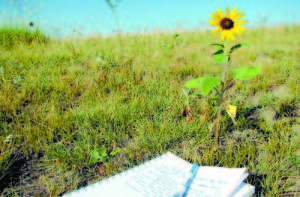
A SCENE AND A NOTEBOOK — “The single wild flower I study, while lying on my stomach that morning on the hilltop above the trading post. The closer I look, the more I see,†wrote Kevin Hancock.
“The goal should not be the eradication or abandonment of one culture in favor of another, but rather the connectivity of cultures. The best of mankind is distributed like a puzzle throughout all the peoples of the world, who, in the end, are not so different after all.†— Kevin Hancock, a quote from the inside cover of “Not for Sale: Finding Center in the Land of Crazy Horse.â€
By Wayne E. Rivet
Staff Writer
Kevin Hancock never expected a leisurely trip to Pine Ridge would ultimately turn into an inspirational journey and a mission to create awareness.
Few venture to the poverty-stricken Indian reservation that stretches some 2.7 million acres in South Dakota.
Fewer take a serious interest to learn about the Lakota nation — some 40,000 people who occupy an isolated yet enchanting place, and who remain deeply committed to their history, traditions and values.
What was first thought of as a vacation aimed at relaxation, rediscovery of one’s own being and satisfying a curiosity about what has happened to this country’s Native people became much more for Kevin Hancock. Pine Ridge opened up Kevin’s mind and heart.
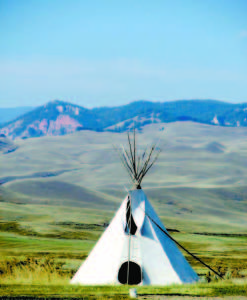 Initially, Kevin documented his visit by jotting his thoughts and experiences into a reporter’s-style notebook and snapping hundreds of photos that captured both the beauty and tragedy of the Pine Ridge Indian Reservation. In a short time, 60 pages were filled with descriptions of sites seen, people met along the way, and thoughts about a culture he was seeing up close and personal for the very first time. Through a series of successive, solo trips to Pine Ridge themes emerged for Kevin, providing powerful lessons along the way:
Initially, Kevin documented his visit by jotting his thoughts and experiences into a reporter’s-style notebook and snapping hundreds of photos that captured both the beauty and tragedy of the Pine Ridge Indian Reservation. In a short time, 60 pages were filled with descriptions of sites seen, people met along the way, and thoughts about a culture he was seeing up close and personal for the very first time. Through a series of successive, solo trips to Pine Ridge themes emerged for Kevin, providing powerful lessons along the way:
- We all come from a tribe, and while the pull of the past is strong, the soul is here to individuate.
- Leadership in the new Aquarian Age is about doing less, not more. Those who hold the power often overreach; they go too far.
- Busyness is not living, and personal growth lies in looking inward, not outward.
- The boundaries that have been set to divide people are not real. In the end, we’re all one tribe.
This fall, Kevin will see an unexpected project come to fruition. His first book, Not for Sale: Finding Center in the Land of Crazy Horse, will be released.
“My journey to Pine Ridge and the life-changing learnings that followed have been organic and spontaneous. In today’s world, a single individual can create a lot of awareness. As my friend from Pine Ridge, Verola Spider says, ‘If we don’t share our stories, they die with us.’ I am excited to share this story with you!†said Kevin, president of Hancock Lumber. “I didn’t see this coming. I feel connected to them, their story and their future and have come to appreciate the Lakota tradition, ‘Mitakuye Oyasin,’ meaning we are all related. I am not trying to do my civic duty; I have all kinds of things I can do here; I am not trying to fix them or save them or straighten them out and tell them how to do things (which is part of the reason I feel they have accepted me). I was just interested in them (the Lakota people). That’s all it was.â€
The pull of the past is strong
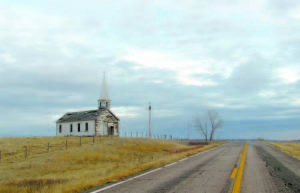
I LOVE THIS PICTURE — On his book’s website, Kevin Hancock writes of this church photograph, “I love this picture. I took it on the first day of my first trip to Pine Ridge. It captures so many elements of the Pine Ridge experience. Nature overshadows the human footprint. The church itself is symbolic of the effort to ‘remake’ the Lakota, yet the church lies abandoned. The church, the road, the telephone poles are the only signs of human existence. From no vantage point can you see another building because it is a long way to the next one. When I took this picture, I just stopped my car in the road and got out. There was no traffic. Except for the wind, it was perfectly silent.â€
The first question, almost always, people ask Kevin is, “Where did this come from?â€
“I am still searching for the answer to that. When I reflect back on my life, there has been a sequence of events going all the way back to when I was a teenager — that I did not connect at the time — that have brought me to Pine Ridge,†Kevin said. “When I was a kid, we went on a family vacation West to the Rocky Mountains, and I loved it. I loved the West.â€
When Kevin was in high school, biology teacher Eugene Whitney took the junior class on a hiking field trip.
“I loved it. I ended up going hiking and backpacking quite a few times. In college, I took one summer and went out to Yellowstone National Park. I worked in the park during my sophomore and junior years as a maid in a hotel, just because I wanted to be out West,†he recalled. “I hiked all summer. In my early 30s, I went on an elk-hunting trip, and loved that. I’ve been back out West a few times again to do that.â€
The other lure has been Kevin’s love of history. He was a history major in college. His first job was at Bridgton Academy, where taught history.
His whole life, he has been a reader of history.
“Over the last 10 to 15 years, I have been particularly interested in American history from the period of 1840 to 1890 when western expansion and Manifest Destiny ruled the country and ran into the Great Plains. I found myself reading more and more about that period in history and the Plains Indians,†he said. “It is a really important, but little paid attention to part of our nation’s history, particularly what happened to the Plains Indians in the process of us becoming a two ocean nation. That part of the story is not told often.â€
A few years ago, Kevin wondered what life is like on the reservation today.
“Just for fun, I thought about going to go see. There was no bigger agenda than that. I spent several months online trying to find a contact on the reservation, which is pretty difficult because the Pine Ridge Reservation is a pretty insular place,†he said.
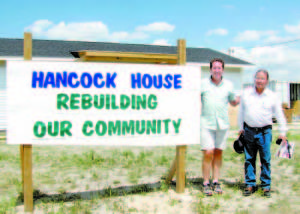 With so many reservations out West, why Pine Ridge? Kevin was aware of Pine Ridge because the first book he read about Native American history was the famous book by Dee Brown, Bury My Heart at Wounded Knee.
With so many reservations out West, why Pine Ridge? Kevin was aware of Pine Ridge because the first book he read about Native American history was the famous book by Dee Brown, Bury My Heart at Wounded Knee.
Pine Ridge Reservation was the site in December 1890 where the last armed conflict between the U.S. Army and the Plains Indians took place.
“1890 isn’t that long ago when you think about it. There are people alive on the reservation today, who knew people who were at the Wounded Knee massacre in December 1890. So, I knew about Pine Ridge from Wounded Knee standpoint. It became known again in the early 1970s when the American Indian Movement (AIM) had their famous 70 to 80-day standoff with federal marshals over the way the reservations were being managed by the federal government. Wounded Knee became famous again, for that reason,†Kevin said.
Statistically, Pine Ridge caught Kevin’s attention because it is one of the largest Indian reservations and also one of the poorest and most desolate places in America. Pine Ridge is a really big place with over 2.7 million acres. Roughly 40,000, primarily Lakota Indians live there. The word, Lakota, essentially means the same thing as Sioux Indians. The band that lives at Pine Ridge, the Oglala Sioux, has a rich history. They are the descendants of Red Cloud and Crazy Horse. Their band defeated Custer and the Seventh Calvary at the infamous Battle of Little Big Horn.
“When you look at American history, you have this critical, but somewhat unknown, period of about 400 years from Columbus in 1492 and the colonization of the Americas to the Battle at Wounded Knee in 1890. It is such an important story because there is the notion that Columbus discovered a new world. It is probably the most famous, basic elementary school sentences about American history, well, new for the Europeans. But, the truth is, people actually lived here,†Kevin said.
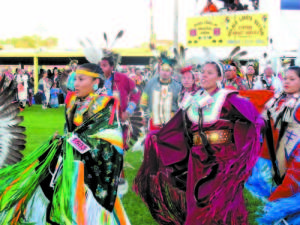 Personal interest and curiosity — no agenda — led Kevin to Pine Ridge.
Personal interest and curiosity — no agenda — led Kevin to Pine Ridge.
“I just wanted to go and do something fun and do some learning that is outside of my every day work,†he said. “I sent a lot of different e-mails, most of which went unanswered until one woman named Pinky responded. She has since become a really good friend of mine.â€
Pinky is a full-blooded Oglala Indian. She lives on the reservation, owns a little grocery store, and runs one of the nonprofit organizations that works with trying to help others find better housing. Pinky agreed to host Kevin, show him around, help him find a place to stay and introduce him to others on the reservation. So, Kevin picked a date, bought a ticket, and went.
“I remember sitting in an airport in Chicago in October, flying to South Dakota. I was nervous thinking, What am I doing? Where am I going? I wasn’t sure about myself. What was bringing me there?†he said.
Kevin visited for five days. When he left and was on the plane headed back to Casco, Maine, Kevin discovered that he had written about 60 pages in his journal.
“I couldn’t go through pages fast enough. I was so captivated by what I saw and what I had experienced. It kept pulling me in,†he recalled.
Pine Ridge became a magnet for Kevin. The people, their way of life, the beauty of reservation, and a gradual calling seemed to pull Kevin back toward the West.
In the following years, he would make several return trips.
And, he slowly realized he had an important story to tell — to anyone who might listen.
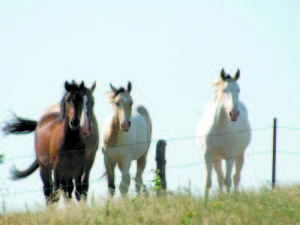 Insights and unfinished business
Insights and unfinished business
“What struck me when I first got there was the beauty of the place. The Plains are so different from what we are used to here in Maine and New England. You can stand on a hilltop and look for 100 miles in all directions and see nothing but grass. It has this real rustic, core beauty to it,†Kevin said. “You can’t see a sign of human life in some places there. It is extremely rural. Nobody goes there.â€
The closest city to the reservation is Rapid City. Depending where one lives on the reservation, it is on average two hours from there. To the south, the next closest city is Denver. It is six hours away. One interstate highway runs about an hour north of the reservation and the other about three hours south of Pine Ridge.
“Nobody goes to Pine Ridge. It is unbelievably remote,†Kevin said. “What really struck me was the lack of businesses and infrastructure. There is no grocery store on the reservation. You can’t buy diapers on the reservation. There is nothing. No economic activity. The lack of economic opportunity — the economic poverty really struck me.â€
Statistics at Pine Ridge are numbing, “so pronounced that they don’t make sense, Kevin pointed out.â€
Consider the following:
- Unemployment rate, roughly 90%. “We just went through a national crisis where unemployment hit 11%. On the reservation it is 90%. If there were 40,000 Lakota Indians living on the reservation, roughly 4,000 would have a job. Of the 4,000 that have a job, only 10% would have a job at a private business. Most of the jobs that do exist — teacher at the school, serve lunch at the school, drive a plow truck, work at the hospital, police department, prison — are government sector jobs. Only 1% has a job in the private sector — approximately 400 people. The median income is $4,000.
- Lowest life expectancy in the Western Hemisphere: Haiti. Not surprising to many. The second lowest is Pine Ridge, South Dakota, — male 48, female 52; suicide rate four times the national average; infant mortality rate five times; diabetes 10 times. “It is an economic, statistical disaster,†Kevin said.
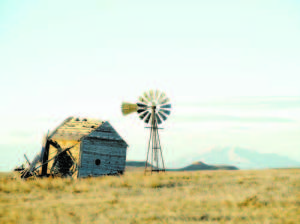 “This is what caught my attention. These are Americans, living right in the middle of our country, and no one really knows about them,†Kevin added. “The biggest thing that is bothersome for them, spiritually, is that they feel forgotten. It’s not so much that they are poor, it’s that they feel forgotten and totally pushed aside, marginalized.â€
“This is what caught my attention. These are Americans, living right in the middle of our country, and no one really knows about them,†Kevin added. “The biggest thing that is bothersome for them, spiritually, is that they feel forgotten. It’s not so much that they are poor, it’s that they feel forgotten and totally pushed aside, marginalized.â€
What caught Kevin’s attention is how they — the Lakota people — got to Pine Ridge. Their ancestors were put there. In the quest for Manifest Destiny, Europeans rounded up and colonized the Natives, forcing them from their nomadic lifestyle.
A quick history lesson
The Oregon Trail opened in the 1840s, followed by the California gold rush. As white people sought fame, fortune and opportunity, they rushed from East to West in wagon trains along the Oregon Trail. The Great Plains was referred to as the great American desert — a place of no value, just a crossing to get to gold country. The first big treaty between the whites and Indians came in 1851. The Lakotas allowed white people to pass through a small amount of land — the width of a wagon. Then in the 1860s, the transcontinental railroad was created, and a new treaty enacted allowing just enough space for the track. In return for safe passage, the U.S. government acknowledged that the entire Great Plains would belong, forever undisturbed, to the Sioux Indians for as long as the grass should grow and the water shall flow.
In 1872, the U.S. government sent an expedition team into the Black Hills, right in the center of the Lakota territory, led by General Custer. Gold was discovered; prospectors started to rush into Indian territory. Government officials said treaty would no longer work, and the Indians would not be able to keep the land.
The Lakota referred to gold as the “yellow metal that makes the white people crazy.†The U.S. government created reservations. One group, the Oglala Sioux under the leadership of Crazy Horse, refused to go to the reservation.
The Battle of Little Big Horn ensued in 1876. Ultimately, the Army won and the Indians were placed on reservations.
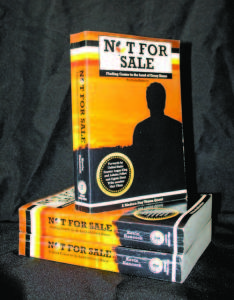
Book: Not For Sale: Finding Center in the Land of Crazy Horse
Cost: $26 plus tax and shipping/handling
Distribution date: September
Website: www.kevindhancock.com
Author: As president of Hancock Lumber Company, Kevin Hancock leads a sixth-generation family business that has operated since 1848. Headquartered in Casco, the company has 10 retail stores and three sawmills, and employs 425 people. The company also owns and manages 12,000 acres of timberland in Cumberland and Oxford counties. In 2014, Timber Processing Magazine recognized Kevin as its forest products industry “Person of the 
Year.†He is a graduate of Lake Region high School and Bowdoin College.
Reviews:
“If you had told me a couple of years ago that my friend, Kevin Hancock, would set off on a quest for enlightenment, sparked by a long-distance astrological reading which would lead him to a sweat lodge in a remote Indian reservation well, let’s just say that ‘skeptical’ doesn’t come close to covering it. What happened next is the amazing story Kevin tells here; part history (and not very pleasant history at that), part spiritual journey, part moving portrait of some extraordinary people, and part leadership manual, this fascinating book will touch you and teach you on many levels.†— Angus S. King Jr., U.S. Senator
“What I have learned through my relationship with Kevin is to remain open-minded, look at everybody as equals and imagine the collective power we can create by coming together. In the beginning, I thought that Kevin and I couldn’t be more different. But, now, I realize that although our journeys started out differently, we are arriving at the same place. Like the Sacred Hoop of the Lakota medicine wheel, the beginning and the ending live in the same spot. Strength comes from the realization that the differences that once tore us apart might now be the opportunities that bring us together. I think this is something that is beginning to happen around the world.â€â€” Nick Tilsen, Askoka Fellow and Oglala Sioux Tribe
“Kevin Hancock’s story touched me, heart and soul. As I read his words, I kept having to chase Amazing Grace out of my head. The archetype behind that song — the archetype of awakening and redemption — permeates every chapter. His is the kind of tale that helps restore my faith in human nature — and gives me hope for the human future.†— Steven Forrest, author of The Inner Sky
Kevin on his first venture in writing: I didn’t set out to do this. This book found me more than I found it. I just set out to visit. I didn’t know I was going to write a book until I started writing it…It’s fun to have an activity, which all that matters is what do I have to say and what am I experiencing. It’s liberating. I have no experience doing this. I have had no training in anything that I have done. I was never trained to teach, but I taught at Bridgton Academy. At Bowdoin at the time, you couldn’t take a class in education. I was never trained to coach, but I continue to coach. I had no experience with business or lumber, but I am running a lumber company. I’ve always learned by doing. Usually, I learn by doing things wrong and wrong again, maybe I need to rethink what I am doing for it to work better. I am an experiential learner. That is how I am approaching this book. There is going to be a time I am going to get some professisonal help. I have deliberately stayed away from it so far because I don’t want to be boxed in.
A “deal†was put in place. Indians would reside on reservations and in exchange, the U.S. government would provide food, clothing, housing, basic tools of agriculture, and convert Indians to Christianity. Everything the Indians needed, the government would provide, so long as they stayed put on the reservations. The government also picked the least desirable pieces of land, far away from white people.
“What was eye opening for me was flash forward to present day — and, that’s how it continues to work. Descendants of those people who fought Custer are still at Pine Ridge, on a reservation, where the government is supposed to take care of everything,†Kevin said. “The government has done, statistically, a terrible job of that. These people live there in crazy economic, financial conditions.â€
One question people ask many Lakotas is, if conditions are so poor at Pine Ridge why don’t they leave for more prosperous areas that could offer better job opportunities?
“Some have. Statistically, they don’t have more success in urban areas. A number of Lakotas in the Minneapolis/St. Paul area, don’t tend to do any better,†he said. “Those that stay, I am told respond, ‘This is where they put us; this is my home.’ Some of the talented people I have met could live somewhere else and succeed. They have said, ‘If you are Lakota, there is no other place on Earth that you can get what you can get here — your values, culture, language, heritage, tradition, family — it is home to us’. Another reason one man stayed after having left the reservation before, ‘I couldn’t get out of my head the life my people are living.’ Population is actually growing on the reservation.â€
What really caught Kevin’s attention is what he considers “not a pretty chapter†in U.S. history.
“If you look how the Indians were treated from 1890 to 1970s, it is hard to digest. Our government policy for almost 100 years was to remake them as white people. I know people at Pine Ridge, who as children over 50 years ago, lived through this. The government would go onto the reservation, go to a house, take the kids without asking permission, ship the kids back East to Indian boarding schools (the most famous one was in Carlisle, Pa.), and ‘remake’ them as white people — cut their hair, change their dress, forbid their native language, and teach them Christianity. The idea was by the time they were 18 to 19 years old, they could be released with white American values, and be able to function in our society,†he said. “It’s a chapter in our history that we haven’t come to terms with.â€
For the Lakota people, there is unfinished business there.
“I have heard several times that despite all the things that have happened — everything taken and how they have been treated — what sticks to them most to this day is no one has ever apologized,†Kevin added. “There has never been a formal apology.â€
In his book, Kevin offers an apology.
“As part of the healing process for them, this country needs to be more aware and acknowledge what happened. In the book, one of my favorite parts, is I write an apology. There has been no official government apology, which would be appropriate and important. In Lakota culture, no one person speaks for all. So, I give an apology and how I feel about what happened. Awareness is powerful. Acknowledgment is powerful. Interest is powerful. Those things can help the Lakota people,†Kevin said. “I have this feeling — how the Lakota function — that they still need to come to terms with what happened to them in order to move forward.â€
A number of people following Kevin’s solo journey to Pine Ridge through his e-mails, photos and website have told him the Lakota’s story “really hit them emotionally.†Kevin commented, “Not because of anything I have done, but because the story tells itself. The story still needs to be told. To some degree, our country has come to terms with slavery; we’ve dealt with that topic, we can’t make it right, but it is open — it has been studied, talked about,†he said. “This reservation story is still in the closet.â€
Growth lies in looking inward, not outward
Pine Ridge is often referred to as “first to worst.â€
The Oglala Sioux were one of the proudest and strongest bands on the Great Plains, leading the charge against Custer and the Seventh Cavalry at the Battle of Little Big Horn. Now, statistically, they face some of the harshest social and economic challenges of any people in our country — from their desperate housing conditions to their shockingly low life expectancy rates and dramatic unemployment status, the issues are real and unchanging.
Being in the lumber business, Kevin immediately took notice of poor housing conditions throughout the reservation.
“Housing is one of the biggest needs on the reservation,†Kevin said. “On my first day touring and driving around, four or five times during the day, Pinky tapped me on the shoulder and told me, ‘That is an ownership home’ — such a rare and unlikely event that it gets pointed out. Most homes are government or tribally-owned rentals. The homes tend to be very small ranches consisting of a tiny kitchen, two small bedrooms, one bathroom and a crawl space in the basement.
“If you go to the crawl space, it is lined with bed sheets because there could be 30 to 40 people staying there on any given night on that cement floor,†Kevin said.
Charitable groups on the reservation build outhouses so people don’t have to use a bucket to go the bathroom and fix holes in rooftops. Conditions are harsh in the winter. A number of people live with no electricity or heat.
After the Battle of Little Big Horn, a “deal†was put in place. In the Treat of Fort Laramie of 1868, the U.S. Government “promisedâ€â€” among many others that were broken — to provide housing for the Indians. Currently, there is a 5,000-home shortage on the Reservation. At a cost of $125,000 per dwelling, the government owes about $625 million in housing to satisfy its end of the deal.
Original promise, government responsible. Currently reality, inadequate and non-existing housing. Pine Ridge needs 5,000 homes.
“You can look around at recent examples where the government has intervened, take Hurricane Katrina, for example. One hurricane destroys the East Coast and it becomes an inarguable call for relief. Within a matter of days, the federal government committed $900 million in disaster relief funding,†Kevin pointed out. “That would more than address the housing needs on the reservation, which has existed for over 100 years. This is a situation that we created, not nature, with the government taking the Native’s land in the first place, making them stay there, and mismanaging how it was to be taken care of. To me, that is an example what caught my attention for this story. We get so interested in what happens to people in other places such as Africa, Asia, Europe, the Middle East, but we pay little attention to what is actually happening in South Dakota. How little interest it gets. How little sympathy it gets. How little money it gets. That’s what really stands out, for me. The lack of interest in these people, the situation that we created.â€
With support from his Hancock Lumber team, Kevin worked with the Lakota community to build a home there that locals call, “The Hancock House.†He also created “The Seventh Power,†a nonprofit organization committed to increasing awareness of the Oglala Sioux tribe, the broken promises made by our nation to all the tribes of the Northern Plains and to the current economic and social challenges of modern-day life at the Pine Ridge Reservation. In addition to awareness, the organization aims to raise funds for projects related to housing construction, healthier diets through a return to traditional food sources, clothing, education and private sector job creation. Last year, Kevin was a guest speaker at Bridgton Academy, and told students about his experiences at Pine Ridge. Touched by Kevin’s story, BA students and faculty members raised nearly $400 during a “Dress Down for Pine Ridge.†The money was earmarked to purchase hats, mittens and gloves to be sent to Pine Ridge.
“I went to Pine Ridge just to check it out for myself. I have now felt called to that place. I have lots of friends there. I am interested, in a small way, of sharing a story that no one knows about,†Kevin said.
We are all one tribe
When Kevin made his first trip to Pine Ridge in the fall of 2012, the experience “fascinated†him in several ways.
He was in awe of the Plains and all of its splendor.
He was “touched†and developed a growing “appreciation†of the Lakota’s deep-rooted culture.
“I was not expecting the experience to be so powerful, but it was,†he said.
In describing the Lakota people, Kevin said, “They are the same as the rest of us. Nice. Funny. Caring. Talented. Smart. Resourceful. Good values. Fun to be around. Warm. Just like us.â€
So many “scenes†Kevin includes in his book could easily have occurred in his hometown of Casco.
“Behind me in line at Subway, two Little League-age boys just came in from a game, dirt on their knees. One kid played a great game and was congratulated by his teammate, ‘Great hit you had.’ They got sandwiches and left. What connects me is that even though they are so different, they are also just the same. Experiences with my work, everywhere I have gone, people are people. We see all these differences, but when you break it all down, people are not so different from one another,†he said.
On the other side of the coin, the Lakota are very different culturally. In spite of all the oppression and a concerted, 100-year-long effort by the U.S. Government to “remake†them as white people, the Lakota have not been remade.
“The language, tradition, and values still exist. It is a communal place. Getting ahead, making lots of money, being busy, and other things that drive the American society are not values that drive them. Their values consist of basic necessities, sharing resources, and living in a spiritually, healthy way. They talk about being a nation within a nation. They consider themselves Americans — they proudly fly American flags on the reservation and celebrate their young warriors who go off and serve in the U.S. military,†Kevin said.
Pine Ridge is not governed by the state of South Dakota, but overseen by the Bureau of Indian Affairs, a sub-department of Department of the Interior. Pine Ridge has its own tribal laws, own court and prison systems, own schools, tribal council and the federal government administers the reservation.
“Everything comes through the government. When it comes time to do business, reservation leaders go to Washington, D.C.,†he said.
But, there is a rebirth taking place on the reservation. People want more independence and want to create more economic activity, thus decreasing total reliance on the government.
“I may be giving them a ‘fresh’ perspective. I have a purpose there, not a big role, a small one,†said Kevin of his discussions with tribal members regarding economic opportunities.
“The Lakota are returning to their core values; retaking control — in their own way — is the key to gaining their independence. They had a system imposed on them that just doesn’t work with their values. When original negotiators went out to talk with the Plains Indians, they arrived and asked that they be brought to their leader. The Indians wondered what they were talking about because they didn’t have one. The Lakota heritage is the lowest amount of government control — no one speaks for all of us.,†Kevin learned.
“After 130 years of being told you are inferior, told you can’t take care of yourself, it weighs heavy on a tribe. There’s a bit of a reawakening happening, which they are starting to rethink all of it. They are starting to think about how as individuals and a community they can gain their independence. My role there — it’s not an official or formal role. I don’t work for a nonprofit, whose job is to help them. I don’t work for a government agency, whose job is to help them. I am just a person who is interested,†he said. “People ask me what do I do there? Not much, really. I work on a few things while I am there, but mostly I talk to people and take in what I see. Right now, there isn’t a whole lot to do there. I don’t have a big agenda.â€
His genuine interest and caring attitude have not gone unnoticed.
“They (the Lakota) are more interested in your heart than your head. As a compliment, you won’t hear them say you are a smart person, but a person with a good heart. In our culture, that may sound funny. How would you know that? When they say it, they mean it because they have watched you, talked to you and feel who you are. When they see that you have a good heart, they grab you,†he said.
A key part that drew Kevin to Pine Ridge was a feeling that roles can be all consuming, and there has to be more than that in life.
“I’m a dad, I’m a husband, employee, businessman, member of a church. You wake up one day and those roles can totally consume you. They are necessary, valuable roles, but they can be all consuming. What I have been exploring within myself and writing about in this book is making sure we all still keep in mind — separate from those roles — there is a person, a soul, in there. When I am sitting on a hilltop on the reservation by myself in the middle of the Great Plains where you can see 80 miles in any direction, at that moment in time, I have no responsibilities to anyone,†he said. “Who am I? Not in a selfish way, but for all of us. There is an independent person there with various interests, needs and spirit. At Pine Ridge, I was interested in reconnecting with myself — outside of my roles…inner reflection…being open to what calls us in life. What gives meaning to us in life? What is your Pine Ridge? What out there is trying to speak or call or be of interest to you that would be so easy to miss inside the busyness of our daily lives?â€
There are lots of people on the reservation trying to help the Lakotas. Kevin Hancock is one of those people.
“The point is, what do you want to do with your life? You don’t have to travel thousands of miles to help others, it may be right in front of you,†Kevin said. “This experience for me has been a call to be connected with myself. There is this energy that has been brought to life within me to help others.â€
Kevin Hancock never expected a simple trip to satisfy a curiosity would place him on a path that including trying his hand at being a writer.
“This book found me more than I found it. If no one ever reads this book, I would still do it. It’s called me to tell this story, share my thoughts, and share my experiences,†he said. “Beyond that, if the book is of interest to others outside the Lakota community, inspires them to help our Native people or some other cause — their own Pine Ridge — that is a bonus to me,†Kevin said. “If this book helps even one Lakota person to see that there are people who care about them to help them process their past and help them think about their future, that’s a bonus too.â€

